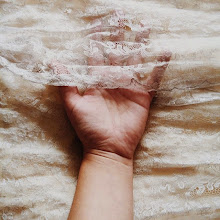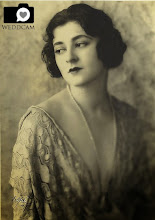Ayer mientras veía en televsión programas de lo más variado, algunos sobre cocina, otros sobre política, otros sobre actualidad, me convencía más y más de que el planteamiento actúal es algo confuso para mi forma de pensar en estos momentos, imagino que también lo será para muchos de vosotros.
Hace tan solo 8 meses decídi probar con una filosofía de vida y de trabajo que siempre me ha inspirado y que había tenído presente, aunque me parecía una utopía, necesitaba intentarlo.
Bien, mi compañera y yo queríamos trabajar desde el punto de vista del oficio, sin hacer una pieza igual a la otra, y trabajando desde una concepción en el que hubiera una simbiosos entre el arte y la artesanía, nada de hacer dos cosas iguales.
Pero es tan complicado empezar...encajaba muy bien la ropa vintage en nuestra forma de pensar, ya que es parte de la historia, del arte, no es un producto insdustrializado, y contaba con buena calidad de la materia prima y sus decoraciones, algo que en estos momentos, siento reconocer que en la industria de la moda da verdadera pena salir a por una simple blusa.
La historia del Atelier y comienza en la artesanía, en el oficio, de la mano de la figura William Morris. Estudié en diferentes escuelas de artes y oficios, y este hecho me marcó para el resto de mi carrera profesional. Buscando incansablemente un oficio artesano. Siempre pensé que el hecho de realizar un producto con tus propias manos hacía otra persona, entregabas algo más que un simple producto en una bolsa, entregabas un gran proporción de honestidad, compromiso y cariño.
Empecé a investigar fórmulas de bellas artes y teatro, combinado con el oficio de la costura.
Reunía desde hace muchos años gran afición a guardar todos los textiles que caían en mis manos, y empecé a probar a realizar piezas con algunos de los encajes antiguos.
De momento seguímos probando, pero lo que si os podemos decir que merece la pena internarlo, o por lo menos a nosotras nos está mereciendo mucho la pena.
Os dejo un extracto de William Morris y su filosofía.
Un saludo. Laura
Yesterday while watching on televsion programs as varied , some about cooking , others about politics, others on today , I more and more convinced that the current approach is somewhat confusing to my mind right now , I guess so I will for many of you .
Just eight months ago I decided to try a philosophy of life and work has always inspired me and I had had in mind, though it seemed a utopia needed to try.
Well, my partner and I wanted to work from the point of view of the trade , doing a piece like another , and working from a conception in which there is a symbiosis of art and crafts, anything to do two things equal .
But it's so hard to start ... fit very well vintage clothing in our way of thinking, as it is part of history , art, insdustrializado is not a product, and had good quality of raw materials and decorations something right now , sorry to recognize that in the fashion industry gives out a real shame for a simple blouse.
The story begins in the Atelier and crafts in the art, the hand of the figure William Morris. Studied in different schools of arts and crafts, and this scored me for the rest of my career. Looking for a job tirelessly craftsman . I always thought that the fact of making a product with your own hands I was someone else, you gave yourself more than just a product in a bag , you gave yourself a large proportion of honesty, commitment and love.
I started researching ways to fine arts and theater , combined with the art of sewing.
Met for many years great hobby to keep all the textiles that fell into my hands, and started to try to make pieces with some old lace.
To continue testing time , but what if you can say it's worth intern , or at least to us is paying us much grief.
Just eight months ago I decided to try a philosophy of life and work has always inspired me and I had had in mind, though it seemed a utopia needed to try.
Well, my partner and I wanted to work from the point of view of the trade , doing a piece like another , and working from a conception in which there is a symbiosis of art and crafts, anything to do two things equal .
But it's so hard to start ... fit very well vintage clothing in our way of thinking, as it is part of history , art, insdustrializado is not a product, and had good quality of raw materials and decorations something right now , sorry to recognize that in the fashion industry gives out a real shame for a simple blouse.
The story begins in the Atelier and crafts in the art, the hand of the figure William Morris. Studied in different schools of arts and crafts, and this scored me for the rest of my career. Looking for a job tirelessly craftsman . I always thought that the fact of making a product with your own hands I was someone else, you gave yourself more than just a product in a bag , you gave yourself a large proportion of honesty, commitment and love.
I started researching ways to fine arts and theater , combined with the art of sewing.
Met for many years great hobby to keep all the textiles that fell into my hands, and started to try to make pieces with some old lace.
To continue testing time , but what if you can say it's worth intern , or at least to us is paying us much grief.
I leave an extract from William Morris and his philosophy.
A greeting. Laura
El movimiento Arts and Crafts ("Artes y Oficios" o también "Artes y Artesanías") fue una escuela artística que surgió en Inglaterra a mediados del siglo XIX, y que se desarrolló en el Reino Unido y en los Estados Unidos durante la segunda mitad del [siglo XIX] y en los comienzos del siglo XX. William Morris creó este movimiento, acuñó el término y fue el miembro de los prerrafaelistas más interesado en la manualidad, retomar el modo de hacer de la edad media, huyendo de la revolución industrial. Tuvo una segunda generación alrededor de 1880 y 1900.
El Arts & Crafts se asocia sobre todo con la figura de William Morris, artesano, impresor, diseñador, escritor, poeta, activista político y, en fin, hombre polifacético que se ocupó de la recuperación de artes y oficios medievales, renegando de las nacientes formas de producción en masa.
Artes y artesanías (arts and crafts) fue un enorme movimiento de ambición intelectual y con frecuencia habilidad artística superlativa, que abarca todo, desde broches esmaltados hasta iglesias, en lugares tan diversos como Budapest y California. Nacido de pensadores y profesionales en la Inglaterra victoriana que desesperó de la confusión adornado, que parecía ser arquitectura y diseño omnipresente, era un movimiento en torno a la integridad. Se trataba de respetar sus materiales, y la forma en que se utilizaban. Se trataba de mostrar cómo se construyeron las cosas, de modo que nunca parecían diferentes de lo que eran en realidad.
Igualmente, se trataba de respetar el Creador. Sobre un fondo de la inmundicia y la degradación o la industrialización, el movimiento quería que la gente trabajase en un entorno feliz, sano, y que disfrutaran de lo que hacen. Uno de los corolarios fundamentales de este enfoque en el medio ambiente era una nueva preocupación con lo doméstico y lo cotidiano. Aunque hay artes y oficios importantes como iglesias y edificios públicos, eran casas y sus contenidos los espacios que más importaban – espacios convenientes, cómodos y funcionales los cuales fueron las demandas del habitante moderno y mejoraron su calidad de vida. Desde la primera exploración de las artes una artesanía ideas de la necesidad de producir muebles y artículos de hogar, que eran a la vez prácticos y agradables estéticamente tomaron el centro del escenario. En el mundo de la arquitectura para el diseñador Charles Robert Ashbee, "las artes y el movimiento a mano comenzó con el objeto de hacer cosas útiles, de hacerlas bien y de hacerlas bellas ; buena calidad y la belleza eran los líderes de los movimientos.
The Arts and Crafts movement was a school of art that emerged in England in the mid -nineteenth century and was developed in the United Kingdom and the United States during the second half the [ nineteenth century ] and in the early twentieth century. William Morris created this movement , coined the term and was the member of the Pre-Raphaelites interested in the craft , how to make resume of the Middle Ages , fleeing the industrial revolution. He had a second generation around 1880 and 1900.
The Arts & Crafts is mostly associated with the figure of William Morris , artisan , printer , designer , writer , poet , political activist and , finally, versatile man who dealt with the recovery of medieval arts and crafts, denying the nascent forms of mass production.
Arts and Crafts ( arts and crafts ) was a huge movement of intellectual ambition and often superlative artistry , covering everything from enamel brooches up churches in places as diverse as California and Budapest . You born thinkers and practitioners in Victorian England who despaired of the ornate confusion that seemed to be ubiquitous architecture and design, was a movement about integrity. It was respect their materials and how they were used . It was to show how things never seemed so different from what they were actually built.
Similarly, it was to respect the Creator. On a background of the filth and degradation or industrialization , the movement wanted people to work in a happy , healthy environment , and enjoy what they do . A key corollary of this approach in the environment was a new concern with the domestic and the everyday . Although there are arts and crafts as important churches and public buildings, houses and their contents were spaces that mattered most - convenient , comfortable and functional spaces which were the demands of the modern inhabitant and improved their quality of life. Since the first exploration of the arts a craft ideas need to produce furniture and household items that were both practical and aesthetically pleasing once took center stage. In the world of architecture for Charles Robert Ashbee designer , " Arts and Crafts movement began in order to do useful things , do them well and make them beautiful , good quality and beauty were the leaders of the terms movements synonyms "











No hay comentarios:
Publicar un comentario